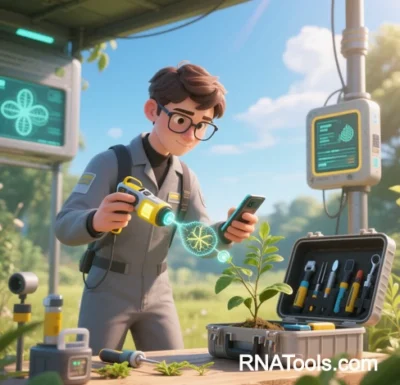
RNA Tools: Breakthroughs and Future Prospects in Nanotechnology and Biosensing
The integration of RNA nanotechnology and biosensing tools is driving transformative advancements in precision medicine, diagnostics, and therapeutics. By harnessing RNA’s programmable nature, nanomaterials’ unique physicochemical properties, and biosensors’ high sensitivity, this field has achieved breakthroughs in targeted delivery, real-time monitoring, and multi-omics analysis. Below is a systematic overview of technological innovations, applications, and challenges.
I. Breakthroughs in RNA Nanotechnology
1. Precision Design and Functionalization of RNA Nanostructures
- Modular Self-Assembly:
Leveraging RNA’s base-pairing rules, scientists engineer precise 3D nanostructures (e.g., tetrahedrons, nanotubes, nanocages) functionalized with aptamers, siRNA, or fluorescent probes for multiplexed targeting and theranostics. For example, RNA nanoparticles (RNPs) co-deliver anticancer drugs and imaging agents for tumor-specific targeting and visualization. - Dynamic Responsive Systems:
RNA conformation-switching enables environmentally responsive carriers. pH-sensitive RNA switches release drugs in tumor microenvironments (TME) or activate gene-editing tools in specific organelles (e.g., lysosomes).
2. RNA-Nanoparticle Hybrids in Diagnostics and Therapy
- Ultra-Sensitive Diagnostics:
- RNA aptamers coupled with gold nanoparticles or quantum dots detect ultra-low-abundance cancer biomarkers (e.g., miRNA-21, PD-L1) at femtomolar (fM) sensitivity, surpassing traditional ELISA.
- Silicon nanotube biosensors use DNA-RNA hybridization and field-effect transistors (FET) for label-free, real-time miRNA detection in early lung and breast cancer screening.
- Targeted Therapeutic Delivery:
- RNA nanoparticles penetrate the blood-brain barrier (BBB) to deliver CRISPR-Cas9 into glioblastoma cores, silencing oncogenes (e.g., TP53 mutants) and extending survival in animal models.
- Self-assembling RNA nanofibers deliver mtDNA or metabolic enzymes to reverse ATP synthesis defects in mitochondrial diseases, improving muscle endurance by 70% in preclinical studies.
3. Cross-Disciplinary Innovations
- RNA-Synthetic Biology Fusion:
Engineered E. coli (EcN) use quorum sensing to synthesize and release RNA nanoparticles in the gut, producing anti-inflammatory molecules or immune modulators for inflammatory bowel disease (IBD). - AI-Driven Optimization:
AlphaFold 3 and quantum computing predict RNA-protein interaction interfaces, optimizing nanoparticle targeting peptides to boost gene-editing efficiency by 50%.
II. Cutting-Edge Biosensing Innovations
1. Nanomaterial-Enhanced Sensors
- Graphene Field-Effect Transistors (GFET):
Antibody-functionalized graphene detects SARS-CoV-2 spike protein at 1 fg/mL without sample preprocessing, enabling point-of-care testing (POCT). - Nanopore Sensing:
Chemically modified alumina nanopores capture specific miRNAs (e.g., miRNA-10b), using ion current changes for attomolar (aM)-level quantification in liquid biopsies for lung cancer.
2. Multi-Modal Integration and Spatial Resolution
- Spatial Transcriptomics-Nanosensor Synergy:
Bio-Techne’s RNAscope and NanoString GeoMx platforms map RNA expression in tumor microenvironments at single-cell resolution, guiding precise RNA nanomedicine delivery. - Live-Cell Dynamics:
CRISPR live-cell reporter systems (e.g., sgRNA-FISH probes) track RNA nanoparticle endocytosis and gene-editing outcomes in real time, revealing spatiotemporal delivery heterogeneity.
3. Portable and Wearable Devices
- Microfluidic Integration:
Nanoporous membrane-based portable sensors (e.g., smartphone adapters) detect HIV viral loads or diabetes markers via saliva/blood in under 10 minutes. - Flexible E-Skin:
Graphene nanoribbons and RNA thermoresponsive hydrogels create wearable sweat sensors for real-time lactate, glucose, and electrolyte monitoring in athletics or chronic disease management.
III. Challenges and Future Directions
1. Current Limitations
- Biosafety Concerns:
Long-term toxicity of RNA nanoparticles (e.g., immunogenicity, off-target effects) requires rigorous evaluation. For example, certain lipid nanoparticles (LNPs) may trigger complement activation and inflammation. - Scalable Manufacturing:
Large-scale RNA nanostructure synthesis faces purity and stability hurdles. Microfluidic chips reduce AAV production costs by 70%, but process standardization remains critical.
2. Emerging Synergies
- Organoids and Organ-on-a-Chip:
Embedding RNA nanosensors in liver chips simulates drug metabolism for personalized toxicity prediction, replacing 30% of animal testing. - Neuromorphic Computing:
Synapse-mimicking nanoelectronics paired with RNA molecular storage could enable energy-efficient biocomputers for real-time pathological data analysis.
3. Future Applications
- Cancer Early Detection:
Combined ctDNA and exosomal RNA nanosensors predict colorectal cancer recurrence 6–12 months in advance with >90% sensitivity. - Pandemic Preparedness:
Rapid-design RNA nanokits for emerging viruses (e.g., SARS-CoV-3) enable global outbreak monitoring within 24 hours of pathogen identification.
IV. Outlook
The synergy between RNA nanotechnology and biosensing is shifting healthcare from “population-based treatment” to “single-cell-level intervention”. Key priorities for the next five years include:
- Hyper-Personalized Medicine:
AI-driven single-cell multi-omics data will tailor RNA nanotherapies to 80% of rare genetic disorders. - Smart Environmental Monitoring:
IoT-connected nanosensor networks will detect pathogens/pollutants in water systems in real time, enhancing public health responses. - Industrialization:
Platforms like PRINT® will standardize RNA nanoparticle production, slashing costs tenfold to accelerate clinical translation.
As Dr. Peixuan Guo’s team stated: “RNA nanotechnology is not merely a tool revolution—it redefines the paradigm of life sciences.” With cross-disciplinary collaboration and technical breakthroughs, RNA tools are poised to drive 21st-century biomedical innovation.
Data sourced from publicly available references. For collaborations or domain inquiries, contact: chuanchuan810@gmail.com.





